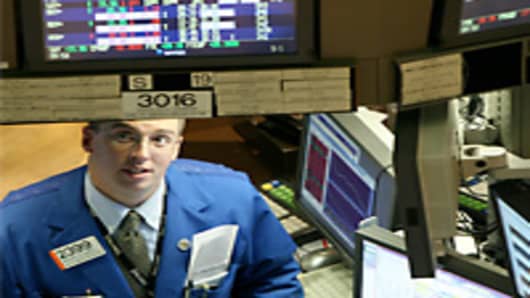Home price data and consumer confidence could help sway sentiment Tuesday, but the markets will be more intent on watching for any new comments from the Federal Reserve .
Fed Chairman Ben Bernanke reminded markets Monday that the labor market remains weak, and the Fed could take more easing action if necessary, in a speech delivered to the National Association for Business Economics annual meeting.
The fact that Bernanke sounded slightly more dovish than his recent comments helped drive stocks higher, push down bond yields and send the dollar lower, as markets readjusted to the idea of possibly more Fed easing.
Bernanke also said further improvements in the unemployment rate requires better demand from consumers and businesses, which he says can be driven by “continued accommodative policies.”
Bernanke’s comments also helped dash speculation that the Fed could move forward its first tightening from late 2014, the forecast of a majority of its members.
Investors can spend more time watching Bernanke Tuesday, as he speaks at 12:45 p.m. to a class at George Washington University in the third of four guest lectures.
The public can view the lecture by clicking here, or see it later on the Fed's web site.
New York Fed President William Dudley also testifies at 10 a.m. before the House Financial Service’s Subcommittee on the European sovereign crisis and the Fed’s role.
There are a few other Fed speakers, including Boston Fed President Eric Rosengren, speaking in London; Dallas Fed President Richard Fisher, speaking on the Fed and economy at 1:20 p.m. in Louisiana, and St. Louis Fed President James Bullard, speaking at 9 p.m. in China.
Consumer confidence is released at 10 a.m., while S&P /Case-Shiller home price data is reported at 9 a.m.
The Treasury issues $35 billion in 2-year notes at 1 p.m.
Fed Driven Rally
The Dow gained 1.2 percent to 13,241, and the S&P 500 rose 1.4 percent to 1416.
The 10-year yield was higher on the day at 2.253 percent, but the 2-year yield fell to 0.34 percent.
Analysts said Bernanke did not really say much new, but did lay out his case for the Fed’s current policies.
“He maybe pushed the odds a little bit, but he’s going to continue to evaluate data as it comes in,” said Charlie Parkhurst of Barclays Treasury desk. “He did stop the down trade, but the curve continues to be steeper on the day.”
Bond yields have been higher since Bernanke testified before Congress earlier in the month.
Traders then heard Bernanke speak more positively about the economy without offering any new guidance on quantitative easing. That created a new dynamic in markets, with slightly higher yields.
The Fed has been conducting an easing program called “operation twist,” aimed at driving down longer term Treasury yields.
Investors are looking to its April meeting for some guidance on “twist,” scheduled to end in June.
The Fed has said if it does more quantitative easing, it could involve the purchase of mortgage securities.
Markets Mayhem
Stocks, meanwhile, recovered last week’s losses and then some in Monday’s bounce higher.
The first quarter, which ends Friday, is on track to be the best first quarter for stocks in 14 years.
Standard and Poor’s analyst Samuel Stovall said, if history is a guide, the first quarter’s momentum could spill into the second quarter, but the gains won’t be as large.
The S&P 500 is up 12.7 percent for the quarter so far.
“If we have a really strong first quarter and a strong fourth quarter of the prior year, what does that mean for the coming second quarter? Believe it or not, it says it gives us a running start,” said Stovall.
“Since 1945, in the eight times the S&P was up 10 percent or more in the first quarter, it gained another 3.3 percent on average in the second quarter and was up 75 percent of the time,” he said.
Stovall said in the 10 times the market was up 5 percent or more in both the first quarter and fourth quarter of the prior year, it was up an average of 4 percent in the second quarter.
In those years, the market was up an average 2.6 percent in April, and the market rose 80 percent of the time.
In the 10 years that had strong fourth quarter, then first quarter performances, the market saw its year low eight of those times in January.
The S&P also finished up an average 22 percent, with all but one year positive. The year that did not see a gain was 2011, which finished flat.
“The magnitude of the advance will not be repeated” in the second quarter,” he said.
Stovall, like other analysts, said the market is due for a correction, but it should be relatively shallow because of the low level of downward volatility in the market lately.
“Because the market is acting as if it is in the very first year of a brand new bull market, when we get a decline, it will likely not be worse than a pullback, meaning a decline of 5 to 10 percent,” he said.
What Else to Watch
Treasury Secretary Timothy Geithner testifies before the House Financial committee on the Treasury’s 2013 budget.
Earnings are expected from Lennar ,McCormick and Walgreen ahead of the opening bell.
Follow Patti Domm on Twitter: @pattidomm
Questions? Comments? Email us at marketinsider@cnbc.com



